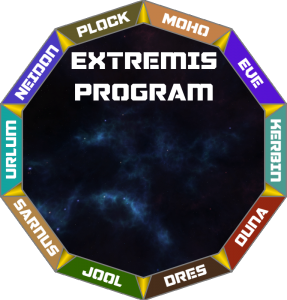|
Category Archive: News
Dec 18 2020
Operations Summary – Weeks of 12/7 & 12/14/20
Mar 25 2020
Ascension and Progenitor Programs Suspending Operations
 Today I made the decision to suspend our rocketry programs for a full review and reassessment on all levels (design, administration, operations, vehicle integration, etc) over the next two months, at least. This move is especially difficult because we started this year out so strong, putting a probe into orbit and once again sending a kerbal up into space after a 5 month hiatus of crewed flight. This month we were also due to launch the first Progeny Mk7-B rocket and begin testing booster recovery and re-use. However despite the increasing momentum we seem to be surpassing our capacity to manage the increasing complexity of our missions and run the risk of compromising safety.
Today I made the decision to suspend our rocketry programs for a full review and reassessment on all levels (design, administration, operations, vehicle integration, etc) over the next two months, at least. This move is especially difficult because we started this year out so strong, putting a probe into orbit and once again sending a kerbal up into space after a 5 month hiatus of crewed flight. This month we were also due to launch the first Progeny Mk7-B rocket and begin testing booster recovery and re-use. However despite the increasing momentum we seem to be surpassing our capacity to manage the increasing complexity of our missions and run the risk of compromising safety.
Initial review of the recent kerbed mission has found out why the rocket did not travel as high as planned – it was 53kg heavier than expected. We don’t have a scale that can measure a rocket after it’s been fully assembled. We know the mass of a rocket because we know the mass of all the individual parts plus the mass of the fuels and the mass of the crew. At some point in this mission improper mass figures were given to the mission design team, or proper ones were given but then failed to be updated when changes were made to the rocket’s assembly. We’re still working down the fault chain to identify all the reasons why this mass discrepancy occurred.
Although this was a relatively minor mistake that did not lead to any actual issues with the mission itself, ignoring it could lead to larger mistakes that in turn lead to disastrous consequences. I don’t feel that it is enough to recognize the issue and say “we’ll get it fixed” as we also continue to move on with operations that may already be compromised. Shutting everything down will allow us to go back to missions and vessels already in progress of being deployed to ensure that they are properly put together.
This decision is also influenced by the recent shut down of the Genesis program, which allowed us to identify and rectify numerous issues that had creeped their way into the program over the years. While we haven’t yet lost a pilot in Genesis due to maintenance or operational errors, there have been numerous close calls and the margins for crewed rocket flight are even tighter, not to mention how much more expensive it is to lose a rocket and unkerbed payload in flight.
This shut down will affect launches and construction only at this time. Engine testing on our static stands will continue and Wernher von Kerman’s team over at R&D also remain unaffected, so some things will continue to move forward. The Progeny Mk7-B that was recently assembled will receive another thorough inspection, mission plans for it and future Mk7-B flights will undergo full reviews. The recent Ascension Mk1 flight will continue to be analyzed and a report published. The upcoming Ascension Mk1 and Mk2 missions are all undergoing the same review scrutiny and we will also be taking another look at what we need to accomplish between now and the late-2021 launch of the first Extremis mission. Crew training will be suspended so our astronauts can be involved in the review aspects oriented towards their mission preparations – we expect training exercises to resume prior to the operational suspension being lifted.
Lead Engineer Simon and Flight Director Lanalye are both in agreement with me on this decision and we are confident that this will work to ensure we finish this year as strong as we started.
– Drew Kerman
Founder, Operations Director
May 22 2018
Extremis Phase Two Reconsiderations
 Today mission planners for Extremis belatedly realized that their initial round of selection for Phase Two trajectories failed to take into account the fact that all trajectories were calculated from a starting equatorial 200km parking orbit. This was done for the sake of simplicity as the multi-flyby maneuver sequencer that ran various possibilities could easily eject the spacecraft from this orbit in any direction needed. In most cases for interplanetary travel the spacecraft will leave Kerbin at an inclined angle. Changing the inclination of an orbit is a very costly maneuver, especially when it is done deep in the gravity well close to the planet. Ideally, the spacecraft would be launched into an inclined orbit suitable from which to perform an escape burn with only a prograde component.
Today mission planners for Extremis belatedly realized that their initial round of selection for Phase Two trajectories failed to take into account the fact that all trajectories were calculated from a starting equatorial 200km parking orbit. This was done for the sake of simplicity as the multi-flyby maneuver sequencer that ran various possibilities could easily eject the spacecraft from this orbit in any direction needed. In most cases for interplanetary travel the spacecraft will leave Kerbin at an inclined angle. Changing the inclination of an orbit is a very costly maneuver, especially when it is done deep in the gravity well close to the planet. Ideally, the spacecraft would be launched into an inclined orbit suitable from which to perform an escape burn with only a prograde component.
What this all means is there is a large segment of trajectories that have been overlooked for Phase Two because their ∆v requirements appeared to exceed the 3km/s requirement when they did not actually need that much energy! Take, for example, a route that goes from Kerbin to Dres to Eve and then out to Urlum in the span of just over 5 years. The initial requirement for this trajectory was 3.513km/s of Δv, however looking at the departure burn requirement from Kerbin it defines a radial and normal burn component totaling 1.68km/s of Δv. If the spacecraft were launched into the properly-inclined orbit this portion of the burn could be almost entirely removed (this all depends on the capabilities of the launcher). Therefore the actual power requirements for this mission could be as low as 1.833km/s, which makes it feasible under the Phase Two considerations of less than 3km/s Δv and less than 10 years of travel time.
The Extremis team will be going back and taking a closer look at trajectories with initial requirements of 3-5km/s to see how many drop below 3km/s when the radial/normal burn component is factored out. Those that remain and cover the gaps left by the one chosen mission will go through the Phase Two 500-iteration route stress test.







